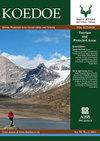史蒂文森-汉密尔顿超级遗址Clovelly和Sterkspruit土壤中草本植物的根瘤菌群
IF 1.1
4区 环境科学与生态学
Q3 BIODIVERSITY CONSERVATION
引用次数: 3
摘要
根际的特点是微生物活性高,以及一系列复杂和动态的物理、化学和生物相互作用,称为“根际效应”(Helliwell等人,2019;Hiltner 1904)。这些相互作用在植物营养中起着至关重要的作用(Raaijmakers et al. 2009;Sørensen 1997)和陆地生态系统的生态系统功能(Singh et al. 2004)。与根际相关的微生物(即根际微生物组或根瘤菌组)代表了微生物多样性的巨大储存库,包括真菌、细菌、线虫、原生动物、藻类、病毒和节肢动物(Berg & Smalla 2009;Bonkowski et al. 2000;Bonkowski, Villenave & Griffiths, 2009;Bulgarelli et al. 2013)。植物物种通过分泌根系分泌物来吸引或排斥周围块状土壤中的特定细菌,从而主动决定其根瘤菌群的组成(Berg & Smalla 2009;Doornbos, Van Loon & Bakker 2012)。因此,根瘤菌群的组成是由紧邻的大块土壤的许多土壤变量决定的,如土壤矿物学、土壤水分含量和pH值(Bardgett et al. 2005;Fierer & Jackson 2006;Myers et al. 2001)。然而,关于特定土壤变量对根瘤菌群组成影响的比较研究很少,因为缺乏合适的研究地点,可以有效地比较不同土壤类型对近距离同一植物物种的影响。本文章由计算机程序翻译,如有差异,请以英文原文为准。
The rhizobiome of herbaceous plants in Clovelly and Sterkspruit soils of the Stevenson–Hamilton supersite
The rhizosphere is characterised by high microbial activity and an array of complex and dynamic physical, chemical and biological interactions termed the ‘rhizosphere effect’ (Helliwell et al. 2019; Hiltner 1904). These interactions play a crucial role in plant nutrition (Raaijmakers et al. 2009; Sørensen 1997) and ecosystem functioning in terrestrial ecosystems (Singh et al. 2004). Microbes associated with the rhizosphere (i.e. the rhizosphere microbiome or rhizobiome) represent a vast reservoir of microbial diversity that includes fungi, bacteria, nematodes, protozoa, algae, viruses and arthropods (Berg & Smalla 2009; Bonkowski et al. 2000; Bonkowski, Villenave & Griffiths 2009; Bulgarelli et al. 2013). Plant species actively determine the composition of their rhizobiome by secreting root exudates that attract or repel specific bacteria from the surrounding bulk soil (Berg & Smalla 2009; Doornbos, Van Loon & Bakker 2012). The composition of the rhizobiome is thus determined by numerous edaphic variables of the immediately surrounding bulk soil such as the soil mineralogy, soil moisture content and pH (Bardgett et al. 2005; Fierer & Jackson 2006; Myers et al. 2001). However, comparative studies on the effect of specific edaphic variables on the composition of the rhizobiome are rare because of a lack of suitable study sites where the influence of different soil types on the same plant species in close proximity can be compared effectively.
求助全文
通过发布文献求助,成功后即可免费获取论文全文。
去求助
来源期刊

Koedoe
BIODIVERSITY CONSERVATION-
CiteScore
3.30
自引率
0.00%
发文量
10
审稿时长
20 weeks
期刊介绍:
Koedoe, with the subtitle ''African Protected Area Conservation and Science'', promotes and contributes to the scientific (biological) and environmental (ecological and biodiversity) conservation practices of Africa by defining the key disciplines that will ensure the existence of a wide variety of plant and animal species in their natural environments (biological diversity) in Africa.
 求助内容:
求助内容: 应助结果提醒方式:
应助结果提醒方式:


